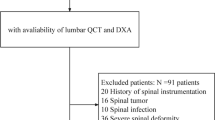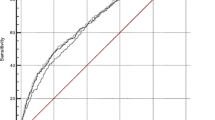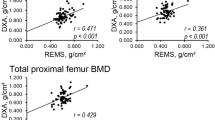Abstract
The aim of this retrospective, cross-sectional, controlled, non-population-based study was to evaluate the specificity and sensitivity of quantitative ultrasonometry (QUS) of the heel and of dual-energy X-ray absorptiometry (DXA) in the prediction of morphometric vertebral fracture in postmenopausal women and to establish whether the combination of the two devices could improve the capacity to identify the presence of vertebral fracture. Also, we tried to identify the best T-score threshold for high risk of vertebral fracture for both QUS and DXA, highlighting the discrepancies between the two methodologies and between the various sites examined with DXA. From 6,300 patients examined by DXA (total body, lumbar spine, total femur, femoral neck), QUS and DXA vertebral morphometry (MXA), we selected 764 postmenopausal women with nontraumatic vertebral fractures; 770 postmenopausal women with normal morphometry were chosen as a control group. Logistic regression analysis yielded odds ratios (ORs) for bone mineral density (BMD) measurements and QUS that were comparable: BMD-total body 4.16, BMD-lumbar spine 4.80, BMD-total femur 3.77, BMD-femoral neck 3.86, and QUS 4.41, without statistical differences even after correction for different confounding variables (menopausal years, weight, height, body mass index, and age). The ORs obtained from different combinations of QUS and DXA results did not show statistically significant differences compared to those from a single method alone. The sensitivity and specificity of all measurements were determined by area using the receiver operating characteristic curve; these were 0.94 for total body, 0.95 for lumbar spine, 0.86 for total femur, 0.89 for femoral neck, and 0.93 for QUS, without statistical difference. The areas under the curve obtained from the combination of QUS and DXA were higher but without statistical significance compared to QUS alone. In conclusion, both QUS and DXA were able to discriminate women with fracture from women without fracture and independently contributed to determining the association with fracture. The combination of QUS and BMD did not improve the diagnostic ability of either individual technique. We found different diagnostic thresholds for QUS and DXA.

Similar content being viewed by others
Explore related subjects
Discover the latest articles and news from researchers in related subjects, suggested using machine learning.References
Ray NF, Chan JK, Thamer M, Melton LJ (1997) Medical expenditures for the treatment of osteoporotic fractures in the United States in 1995: report from National Osteoporosis Foundation. J Bone Miner Res 12:24–35
Melton LJ, Thamer M, Ray NF, Chan JK, Chesnut CH, Einhorn TA, Johnston CC, Raizs LG, Silverman SL, Siris ES (1997) Fractures attributable to osteoporosis: report from the National Osteoporosis Foundation. J Bone Miner Res 12:16–23
Melton LJ, Chrischilles EA, Cooper C Lane AW, Riggs BL (1992) How many women have osteoporosis? J Bone Miner Res 7:1005–1010
Mazess RB, Peppler WW, Chesney RW, Lange TA, Lidgren U, Smith E Jr (1984) Total body and regional bone mineral by dual-photon absorptiometry in metabolic bone disease. Calcif Tissue Int 36:8–13
Mazess RB, Barden HS (1988) Measurement of bone by dual-photon absorptiometry (DPA) and dual-energy-X-ray absorptiometry (DEXA). Ann Chir Gynaecol 77:197–203
Nuti R, Martini G, Righi G, Frediani B, Turchettti V (1991) Comparison of total body measurements by dual-energy X-ray absorptiometry and dual photon absorptiometry. J Bone Miner Res 6:681–687
Black DM, Cummings SR, Genant HK, Nevitt MD, Palermo L, Browner W (1992) Axial and appendicular bone density predict fractures in older women. J Bone Miner Res 7:633–638
Nevitt MC, Johnell O, Black DM, Ensrud K, Genant HK, Cummings SR (1994) Bone mineral density predicts non-spine fractures in very elderly women. Study of Osteoporotic Fractures research group. Osteoporos Int 4:325–331
Cummings SR, Black DM, Nevitt MC, Browner W, Cauley J, Ensrud K, Genant HK, Palermo L, Schott J, Vogt TM (1993) Bone density at various sites for prediction of hip fractures. The Study of Osteoporotic Fractures research group. Lancet 341:72–75
Gluer CC, Wu CY, Genant HK (1993) Broadband ultrasound attenuation signals depend on trabecular orientation: an in vitro study. Osteoporos Int 3:185–191
Gluer CC, Wu CY, Jergas M, Goldstein S, Genant H (1994) Three quantitative ultrasound parameters reflect bone structure. Calcif Tissue Int 55:46–52
Bouxsein ML, Radloff SE (1997) Quantitative ultrasound of the calcaneus reflects the mechanical properties of calcaneal trabecular bone. J Bone Miner Res 12:839–846
Cadossi R, Canè V (1996) Pathways of transmission of ultrasound energy through the distal metaphysic of the second phalanx of pigs: an in vitro study. Osteoporosis Int 6:196–206
Mazess RB (2000) Quantitative heel ultrasound as a predictor of osteoporosis. Med J Aust 172:245–247
Mazess RB (1996). Screening for osteoporosis: what is the role of heel ultrasound? Med J Aust 165:174–175
Gardsell P, Johnell O, Nilsson BE, Gullberg B (1993) Predicting various fragility fractures in women by forearm bone densitometry: a follow-up study. Calcif Tissue Int 52:348–353
Faulkner KG, McClung MR, Coleman LJ, Kingston-Sandal E (1994) Quantitative ultrasound of the heel: correlation with densitometric measurements at different skeletal sites. Osteoporos Int 4:42–47
Gonnelli S, Cepollaro C, Agnusdei D, Calmieri R, Rossi S, Gennai C (1995) Diagnostic value of ultrasound analysis and bone densitometry as predictors of vertebral deformity in postmenopausal women. Osteoporos Int 5:413–418
Hartl F, Tyndall A, Kraenzlin M, Bachmeier C, Guckel C, Senn U, Hans D, Theiler R (2002) Discriminatory ability of quantitative ultrasound parameters and bone mineral density in a population-based sample of postmenopausal women with vertebral fractures: results of the Basel Osteoporosis Study. J Bone Miner Res 17:321–330
Bauer DC, Gluer CC, Genant HK, Stone K (1995) Quantitative ultrasound and vertebral fracture in postmenopausal women. J Bone Miner Res 10:353–358
Thompson PW, Taylor J, Oliver R, Fisher A Quantitative ultrasound (QUS) of the heel predicts wrist and osteoporosis-related fractures in women aged 45–75 years. J Clin Densitom 1998;1:219–225.
Hans D, Dargent-Molina P, Schott AM, Sebert JL, Cornier C, Kotzki PO, Delmas PD, Pouilles JM, Breart G, Meunier PJ (1996) Ultrasonographic heel measurements to predict hip fracture in elderly women: the EPIDOS prospective study. Lancet 348:511–514
Gnudi S, Ripamonti C, Malavolta N (2000) Quantitative ultrasound and bone densitometry to evaluate the risk of nonspine fractures: a prospective study. Osteoporos Int 11:518–523
Huang C, Ross PD, Yates AJ, Walkner RE, Imose K, Emi K, Wasnich RD (1998) Prediction of fracture risk by radiographic absorptiometry and quantitative ultrasound: a prospective study. Calcif Tissue Int 63:380–384
Knapp KM, Blake GM, Spector TD, Fogelman I (2001) Multisite quantitative ultrasound: precision, age and menopause-related changes, fracture discrimination, and T-score equivalence with dual-energy X-ray absorptiometry. Osteoporos Int 12:456–464
Mikhail MB, Flaster E, Aloia JF (1999) Stiffness in discrimination of patients with vertebral fractures. Osteoporos Int 9:24–28
Ross P, Huang C, Davis J, Imose K, Yates J, Vogel J, Wasnich R (1995) Predicting vertebral deformity using bone densitometry at various skeletal sites and calcaneus ultrasound. Bone 16:325–332
Schott AM, Weill-Engerer S, Hans D, Duboeuf F, Delmas PD, Meunier PJ (1995) Ultrasound discriminates patients with hip fracture equally well as dual energy X-ray absorptiometry and independently of bone mineral density. J Bone Miner Res 10:243–249
Bauer DC, Gluer CC, Cauley JA, Vogt TM, Ensrud KE, Genant HK, Black DM (1997) Broadband ultrasound attenuation predicts fracture strongly and independently of densitometry in older women: a prospective study. Study of Osteoporotic Fractures research group. Arch Intern Med 157:629–634
Huopio J, Kroger H, Honkanen R, et al. (2004) Calcaneal ultrasound predicts early postmenopausal fractures as well as axial BMD. A prospective study of 422 women. Osteoporos Int 15:190–195
Khaw KT, Reeve J, Luben R, Bingham S, Welch A, Wareham N, Oakes S, Day N (2004) Prediction of total and hip fracture risk in men and women by quantitative ultrasound of the calcaneus: EPIC-Norfolk Prospective Population Study. Lancet 17:197–202
Laval-Jeantet AM, Bergot C, Williams M, Davidson K, Laval-Jeantet M (1995) Dual energy X-ray absorptiometry of the calcaneus: comparison with vertebral dual-energy X-ray absorptiometry and quantitative computed tomography. Calcif Tissue Int 56:14–18
Ekman A, Michaëlsson K, Petren-Mallmin M, Ljunghall S, Mallmin H (2001) DXA of the hip and heel ultrasound but not densitometry of the fingers can discriminate female hip fracture patients from controls: a comparison between four different methods. Osteoporos Int 12:185–191
Gluer CC, Cummings SR, Bauer DC, Stone K, Pressman A, Mathur A, Genant HK (1996) Osteoporosis: association of recent fractures with quantitative ultrasound findings. Radiology 199:725–732
Di Stefano M, Isaia GC (2002) Ability of ultrasound bone profiler score (UBPS) to discriminate between fractured and not fractured osteoporotic women. Ultrasound Med Biol 28:1485–1489
Cepollaro C, Gonnelli S, Pondrelli C, Martini S, Montagnani A, Rossi S, Gennari L, Gennari C (1997) The combined use of ultrasound and densitometry in the prediction of vertebral fracture. Br J Radiol 70:691–696
Pinheiro MM, Castro CHM, Frisoli A Jr, Szejnfeld VL (2003) Discriminatory ability of quantitative ultrasound measurement is similar to dual-energy X-ray absorptiometry in a Brazilian women population with osteoporotic fracture. Calcif Tissue Int 73:555–564
Frost ML, Blake GM, Fogelman I (2001) Does the combination of quantitative ultrasound and dual-energy X-ray absorptiometry improve fracture discrimination? Osteoporos Int 12:471–477
Knapp KM, Blake GM, Spector TD, Fogelman I (2001) Multisite quantitative ultrasound: precision, age- and menopause-related changes, fracture discrimination, and T-score equivalence with dual energy X-ray absorptiometry. Osteoporos Int 12:456–464
Damilakis J, Persinakis K, Gourtsoyiannis N (2001) Imaging ultrasonometry of the calcaneus: optimum T-score threshold for the identification of osteoporotic subjects. Calcif Tissue Int 68:219–224
Frost ML, Blake GM, Fogelman I (2000) Can the WHO criteria for diagnosing of osteoporosis be applied to calcaneal quantitative ultrasound? Osteoporos Int 11:321–330
Rea JA, Chen MB, Li J, Marsh E, Fan B, Blake GM, Steiger P, Smith IG, Genant HK, Fogelman I (2001) Vertebral morphometry: a comparison of long-term precision of morphometric X-ray absorptiometry and morphometric radiography in normal and osteoporotic subjects. Osteoporos Int 12:158–166
Ferrar L, Jiang G, Barrington NA, Eastell R (2000) Identification of vertebral deformities in women: comparison of radiological assessment and quantitative morphometry using morphometric radiography and morphometric X-ray absorptiometry. J Bone Miner Res 15:575–585
Felsemberg D, Gowin W, Diessel E, Armbrust S, Mews J (1995) Recent developments in DXA. Quality of new DXA/MXA-devices for densitometry and morphometry. Eur J Radiol 20:179–184
Gowin W, Diessel E, Mews J, Hoja T, Felsemberg D (1997) Vertebral morphometry with DXA-MXA equipment—an equipment comparison. Dual X-ray absoptiometry/morphometric X-ray absorptiometry. Rofo 166:140–145
Hanley J, McNeil B (1982) The meaning and use of the area under a receiver operating characteristic (ROC) curve. Radiology 143:29–36
Peretz A, De Maertelaer V, Morris M, Wouters M, Bergmann P (1999) E of quantitative ultrasound and dual X-ray absorptiometry measurements in women with and without fractures. J Clin Densitom 2:127–133
Pearson D, Masud T, Sahota O, Earnshaw S, Hosking D (2003) A comparison of calcaneal dual-energy X-ray absorptiometry and calcaneal ultrasound for predicting the diagnosis of osteoporosis from hip and spine bone densitometry. J Clin Densitom 6:345–352
Wuster C, Albanese C, De Aloysio D, Dubeuf F, Gambacciani M, Gonnelli S, Gluer CC, Hans D, Joly J, Reginster JY, De Terlizzi F, Cadossi R (2000) Phalangeal osteosonogrammetry study: age-related changes, diagnostic sensitivity, and discrimination power. The Phalangeal Osteosonogrammetry Study Group. J Bone Miner Res 15:1603–1614
Author information
Authors and Affiliations
Corresponding author
Rights and permissions
About this article
Cite this article
Frediani, B., Acciai, C., Falsetti, P. et al. Calcaneus Ultrasonometry and Dual-Energy X-Ray Absorptiometry for the Evaluation of Vertebral Fracture Risk. Calcif Tissue Int 79, 223–229 (2006). https://doi.org/10.1007/s00223-005-0098-4
Received:
Accepted:
Published:
Issue Date:
DOI: https://doi.org/10.1007/s00223-005-0098-4




